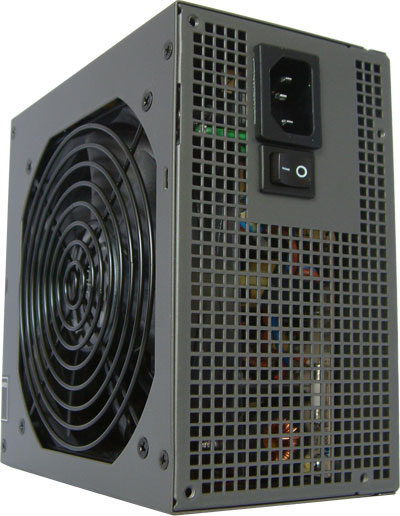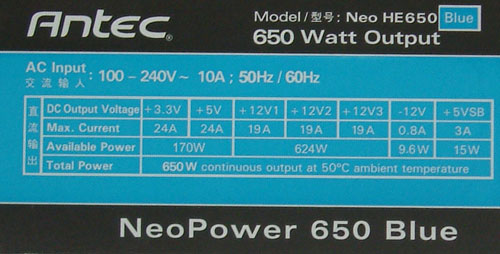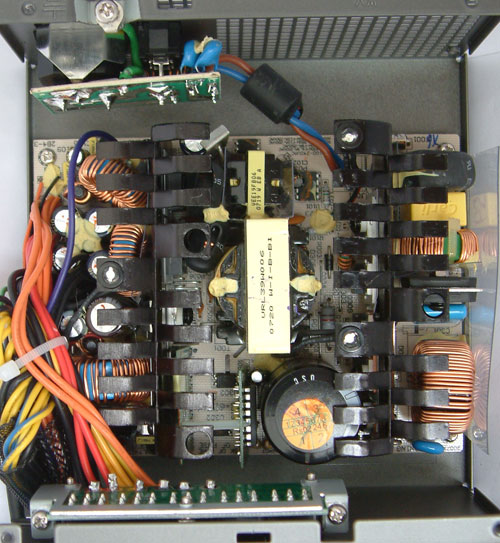Power Supply Roundup: 650W-680W
by Christoph Katzer on February 21, 2008 2:00 AM EST- Posted in
- Cases/Cooling/PSUs
Antec NeoPower 650 Blue

The NeoPower 650 Blue is a new entrant in the market that hasn't received much attention until now. It comes in a dark anthracite color called Gunmetal Black. The NeoPower 650 Blue appearance is typical of Antec PSU, with little to set it apart from other models. It has a 120mm fan on the bottom of the power supply that blows at the heatsinks inside. The back features square-shaped holes over the majority of the surface. The PSU comes in Antec's standard package with a paper shell to protect the power supply.

Like other power supplies from Antec, the NeoPower comes with three 12V rails rated at 19A. The total combined power of the rails is 624W, which is normal for a 650W power supply, and the 3.3V and 5V combined power is 170W. In fact, all the other power supplies today have the exact same combined power rating.

The NeoPower 650 Blue comes with a partial cable management system, allowing the user to disconnect several cables. The jacks on the PSU are a 6-pin design, which has proven effective with other models and manufacturers. With cable management, it is crucial to have a good connection between the cables and the power supply in order to avoid increasing the resistance.

Opening this unit shows a design we've seen quite a few times now. You can see several small holes in the heatsinks, three of which hold the blue LEDs. These LEDs light up when the system is in operation, illuminating the PSU and case interior. The two heatsinks look quite tiny, but with good designs and a moderate 650W rating there is no need for bulky heatsinks. Later we will see that this unit has a high level of efficiency, which leaves less heat to dissipate. While the Seasonic design and layout have been around a while, they still do quite well. As competition heats up, we expect to see some new designs, but there is no need yet. As the saying goes, if it's not broken, don't fix it.










23 Comments
View All Comments
strikeback03 - Friday, February 22, 2008 - link
If you check various Anandtech articles their power draw charts are typically done with a Kill-a-watt meter at the wall. So multiply those numbers by approximately 0.8 and you will have an idea of what those components draw together from the PSU.I built a system for the lab here using an E2180, P965, 2x1GB DDR2-800, 1 DVD, 1 HDD. With a fanless 8500GT idly power at the wall was around 90 watts, I never cheacked load (card had issues). With an 8800GTS 640 idle power at the wall is about 135W, at full load around 210W. System is using an Earthwatts 380.
Christoph Katzer - Thursday, February 21, 2008 - link
Just check the diagram, a 650W unit needs to have at least 150 watts drawn before it has a decent efficiency. I was running a 4000+, 7800GTX, couple of drives and 2 gig of ram and didnt come over 150 watts fully loaded. So just imagine how low the actual power consumption is nowadays and how cool everybody looks with their 1000 watts unit which is drawing only around 150 watts with an efficiency of maybe just 70%.Before choosing a new PSU you would need to know the rough amount of power you need while operating the most used app on the PC. This is at most average PCs 100 to 150 watts and for that a 500-650W PSU is just the best choice.
Super Nade - Thursday, February 21, 2008 - link
Hi,How are you arriving at your numbers for regulation? What kind of a load are you using as "idle" to compute the percentages? Is it the manufacturer supplied minimum values or is it something you have chosen at your discretion? I hope you are not calculating stuff based on 12.00, 5.00 and 3.30 values!
Also, why did you guys drop the rail-wise load distribution charts and the cross-loading tests? That was quite informative and nice to compare units at a glance. These percentages do not convey as much information.
Another suggestion I have would be to use standard, yet very simple statistical calculations (mean, standard deviation, variance) instead of these percentages.
Best wishes,
Super Nade @ OCFoums
Christoph Katzer - Thursday, February 21, 2008 - link
We needed to cut some info to make the articles shorter, but I can get those back on next time.Griswold - Thursday, February 21, 2008 - link
... when we arrived at the more reasonable 400-550W range.Dont get me wrong, Christoph is doing a great job with these reviews but most if not all of them are for PSUs that are a wee bit too oversized for many people - even here at AT.
jonnyGURU - Thursday, February 21, 2008 - link
The problem is this community is very much divided when it comes to power consumption. Many people - even here at AT, may not be using SLI. The most decisive factor in power needs is what GPU you're using and how many of them you have. Given the current selection of SLI or Crossfire capable graphics cards on the market today, I would NEVER suggest anyone use a 400-550W power supply for any of them. Yes, you can run a pair of 8800 GT's off of a 500W for some time, but nobody thinks about the long term effects of running a PSU at 75%+ capability for extended periods of time inside a 40°C typical operating temperature.Of course, SLI and Crossfire is not the majority of the populus. Dual processor even less so, so you are correct in the statement that most PSU's are "oversized" for many people.
But that brings me back to the point Christoph made; "Most users don't need even 650W, but it's more difficult to find good quality PSUs in the 300-500W range." This is TRUE. Yes, the Antec EarthWatts 500W is "adequate," but you're fooling yourself if you think it's near the quality of a CWT built Corsair, Thermaltake or Xigmatek. It's not cost effective to make these higher wattage, higher quality units in lower wattages and then price them to be competitive with "it'll do" units like the low end Seasonics. Again, is the Seasonic adequate power? Yes. If not stressed over long periods will they last seemingly forever? Probably. But the better quality units are in fact in the higher wattage range.
yyrkoon - Friday, February 22, 2008 - link
Hi Jonny, Just going by what Christopher said, it would sound like a lot of systems could(possibly) not even come close to stressing a 500W PSU. I myself even bought a video card thinking of this(nv 7600GT). SO with an E6550 overclocked to 2.8Ghz, 2GB of DDR @ 2.0v, a CD/DVD burner, 7600GT , with 5HDDs how much power could I even be using ? Under a full load I doubt it would be much more than 300W, even if I had all my drives hammered at once(which never happens). Not only that, I use a reverse ATX case where the PSU sits on the bottom of the case, and draws air in from the bottom. Am I the norm ? Probably not, but I am sure there are many others who take all these things into consideration before building a system.Sure, hardcore enthusiasts who *must* have dual - quad GPUs will need lots of power, but I think if someone were to take an *accurate* poll, these users could not possibly make up for more than %5 of total computer users out there(and it is probably much lower than that).
Now, if you are THE Jonny Guru, I must say keep up the good work, I based my PSU buying decision partially on your review of the EarthWATTS 500. It has not let me down yet, and going from past experience, I doubt it will any time in the near future(for the next couple of years anyhow).
jonnyGURU - Friday, February 22, 2008 - link
Again, I never said that SLI or even a single high end graphics card is "the norm." No offense, but you only have a 7600GT. Not a high end graphics card and certainly not something that requires more than a 500W PSU. Heck... a 400W PSU. But that's what either Chris or I are saying: If you want a really good quality PSU, you can't usually find them in the lower wattage. It's simply not cost effective to spend $100 on the BOM to build a top notch PSU only to have to compete with other "it'll do" PSU's that sell for under $100!I didn't necessarily say that anyone NEEDS these high quality PSU's, regardless of wattage, but do people really NEED to drive Jaguars, Lexus or Infiniti? No. They don't. But if you WANT a high quality PSU, regardless of what you're powering with it, what's wrong with going out and getting a 650W, 800W or even 1000W to get that kind of quality? Who are we to tell people how to spend their money?
yyrkoon - Saturday, February 23, 2008 - link
Can not say I agree with your Car<->PSU analogy. A luxury car is not necessarily better, and in the case of Jaguar, there are several 'lesser' manufacturers who make twice the car, for half as much. I do understand what you meant, and mean by quality PSUs.Oh, and 'no offense' taken on the 7600GT, most people do not realize that if you're only playing on a 19" LCD @ 1440x900, that you do not NEED a freeking $500usd GFX card. It'll play just about any title fine, and most of the games I run are set at maximum settings. I also wont move to Vista, and Directx 10 anytime soon . . .
yyrkoon - Thursday, February 21, 2008 - link
Heh, sorry couldn't resist, although I suspect the Antec was manufactured by Seasonic, couldn't say for sure on the others. Anyhow . . ." Most users don't need even 650W, but it's more difficult to find good quality PSUs in the 300-500W range, "
Antec EarhWATTS 500, using it myself, works very good, and is manufactured by Seasonic(or so I have read). Its also selling for less than $50 at newegg last I checked. Seasonic also makes a nice 500W'rs I think.
You guys said something about Seasonic pioneering the no frills look, and efficiency etc, and they started building PSUs in 2002 ? No idea, but I've read that PC Power and Cooling has been around since the 80's, and these have been their 'trademarks'. Assuming what I am saying here is accurate, I find it funny that you would mention these things about Seasonic as though they were the original OEM to have this philosophy.